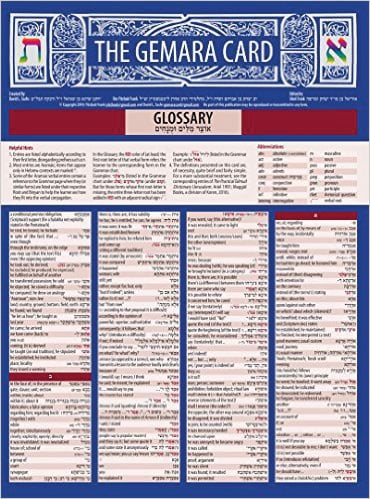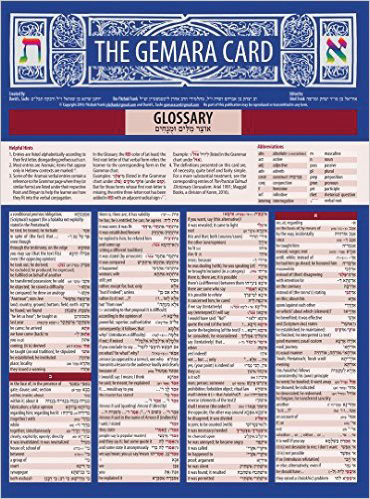
Jerusalem—Gemara, one of the most ancient written forms of the Oral Law, has undergone little modernization in its almost 2,000 years of existence. The most wide-sweeping update in contemporary times was perhaps the release of the most recent Vilna edition of the Talmud in the 1870s. However, in recent times, efforts have been made to bridge the two millennia gap between the Amoraim and our generation, each with its unique take on how to accomplish this. Joining the esteemed company of Artscroll’s Schottenstein, Koren’s latest Steinsaltz, and the now-defunct Yesodei HaTorah’s bookmark is a new innovation: The Gemara Card. Behind this project is a New Jersey resident, Dave Sachs.
Sachs grew up in Livingston, NJ, attending the Agudath Israel Conservative synagogue in West Caldwell. His upbringing, while not Orthodox, was certainly traditional, instilling in Dave important values and ceremonies of his faith, such as belief in God, praying in a synagogue and eating family meals together on Shabbat. These basic values blossomed into a hunger for knowledge as he grew up, leading Sachs to become involved in NCSY events during high school, and eventually resulting in him attending NCSY’s The Jerusalem Journey (TJJ) Israel-experience trip at the age of 16. After high school, Dave studied engineering in Maryland University and used his energy and passion for Judaism to help inspire other students in Hillel, Chabad, Maimonides and other Jewish organizations on campus.
Sach’s religious momentum took him afterward to Israel, where he joined a post-graduate Torah-learning program in Yeshivat Hamivtar. His background immediately caused him some difficulties in studying Gemara, as Talmudic Aramaic was not one of the subjects that was stressed in his Hebrew-school education. He would sit hours on end in the Beit Midrash, with a Gemara open on one side and a dictionary on the other, eventually deciding to start writing a “cheat sheet” of the most common terms. As this reference sheet, and his Gemara skills, continued to grow, many of Dave’s friends asked for copies as well, and he realized that this project, started as a crutch to compensate for missing Aramaic language skills, could be a useful aid to even the most practiced Gemara learner. Looking back on his years in Maryland, where most of the analysis-oriented engineering classes encouraged condensing reference information into one sheet to bring to an exam, Sachs realized that this same principle could be applied to the equally analytic study of Talmud; and, thus, the creation of the professional Gemara “cheat sheet” began.
When beginning to compile material for this project, Sachs felt a little bit overwhelmed with the prospect of creating a comprehensive Gemara reference sheet. “I didn’t really feel like I had the authority, knowledge or experience to write a Talmudic reference by myself,” admitted Sachs, “so I started to think about someone more learned to partner with.” The first individual whom he thought of, who had coincidentally given a friend a ride from Efrat to Jerusalem a few weeks earlier, was Rabbi Yitzhak Frank, author of the Practical Talmud Dictionary. Dave reached out to Rabbi Frank, and after much back and forth, eventually met with the rabbi and his wife in their Sanhedria home and presented his vision. Rabbi Frank immediately warmed up to the idea, and added a few of his own insights to the project, expanding the sheet from a word list to also include other very practical features. After seven years of hard work together, including countless hours of fiddling with graphic design, correcting mistakes and eventually negotiating with Koren Publishers Jerusalem to print the card, their project has now been completed. For Sachs, one of the biggest highlights was the bond he formed with Rabbi Frank while working on the Gemara card. “Looking back, it was very special to work with one of the world’s leading authorities in Talmudic Aramaic,” Sachs said. “It’s been beyond special to share my personal growth with Rabbi Frank, and, now, with all of the Jewish people.”
The Gemara Card itself is a three-page, laminated fold-out sheet of paper. The first three pages are a glossary of over 720 terms, built of off Sach’s original handwritten reference sheet from his time in Yeshivat Hamivtar. The back page contains a list of rashei teivot, over 412 abbreviations, as well as a guide to Gemara grammar, loosely based on Rabbi Frank’s well-known grammar wheel and including 52 conjugated verb combinations. There is a list of 107 of the Talmudic sages, organized by chronological order and geographic location, and, at the very end, there is a small conversion table between the metric and imperial systems of measurements and the ancient units mentioned in the Gemara, as well as a small reference table for the archaic curved script typically used for Rashi’s commentary in the Vilna Talmud. All in all, it features nearly every piece of quick reference material needed during routine Gemara study.
Aside from his pleasure in using his own skills and growth to help others in their study of Talmud, Sachs believes that his own story can inspire others, no matter what their background, to make their own unique contribution to the Jewish people and innovate the time-old study of Torah. “You do not have to be a talmid chacham in order to contribute to the Jewish community,” concluded Dave. “Everyone has their own unique set of strengths and experiences and they should feel empowered to find paths for Jewish involvement that align with who they are.”
The Gemara Card reference pamphlet, co-authored by Rabbi Yitzhak Frank and New Jersey-native David Sachs, is available from Koren Publishers online and in many Judaica stores around the world, for $4.95. Coming soon: The Gemara Card in Hebrew, for Israelis to be able to take advantage of this amazing resource as well.
By Tzvi Silver/JLNJ Israel











